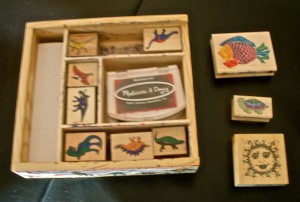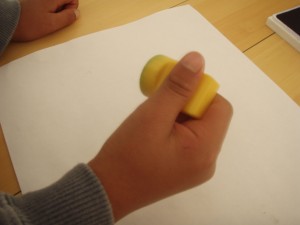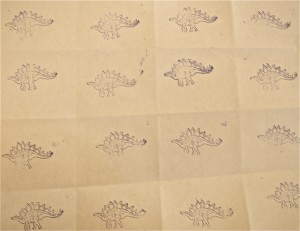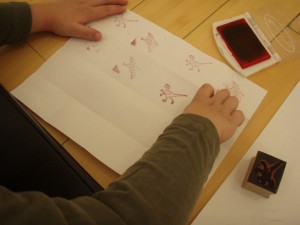I am a big fan of finding the least expensive way to approach a task. I always love a bargain. Purchasing stamps, I make an exception and don’t compromise. Wooden stamps have an incredible number of fine and visual motor benefits, but if using the less expensive, small plastic stamps, the hand strengthening benefits are lost. In fact, the child will hold them in a way that is counterproductive to attempts to strengthen the fingers.
Wooden stamps are pricier that their counterpart, but one or two wood stamps rather than 20 small plastic knockoffs is worth the trade-off. Handy folks can purchase the cheaper models, pry the rubber off and glue it to a wooden block (approximately 1″ square).
Using wooden stamps stretch the thumb away from the palm and the fingers have to curl around to grasp the other side of the stamp. It requires active work from all the finger muscles.
Benefits:
- The big space between the thumb and fingers is called the “Web Space” and is very important for controlling the pencil. When holding the stamp correctly, the muscles that create the web space get stronger.
- The process of stamping the ink pad, then the paper is a simple motor sequence (an important component of motor planning).
- Holding the paper steady with the non-dominant hand turns this into a bilateral activity.
- Stamping in a specific place incorporates eye hand motor coordination demands.
- Creating a design or pattern with stamps activates creativity and visual perceptual reasoning.
Directions:
1. Be sure the thumb is stretched across to one side of the stamp and the other fingers grasp the other side, creating an arc in the hand.
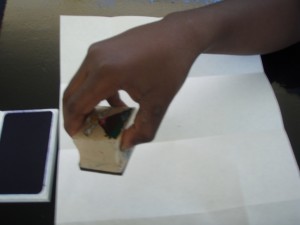
Smaller stamps (pictured below) allow the child to “cheat” by clutching the side of the stamp against the side of the index finger. The important muscles to get strong in this activity are no longer activated.
This actually strengthens the wrong muscle group. So, make sure the child is holding the stamp correctly. By holding the stamp correctly the child develops the motor control necessary for acquiring the proper mechanics for holding and using a crayon, marker, pencil and pen.
The hand strengthening that occurs also builds endurance. For the youngest children in daycare and preschool, stamping activates a new group of muscles in the thumb and fingers. For older children, Kindergarten and beyond, it continues the strengthening process but also builds endurance so they will have more staying power for fine motor tasks such as writing.
2. For very young children (2-3 years), stamping paper randomly is more than enough challenge.
3. Fold a piece of paper into squares and have the child stamp inside each square one time.
4. For older children, specifying a pattern adds an interesting challenge (older 3’s on).
Getting more challenging (A-B-C PATTERNS):
Special Considerations and Extensions:
- For the younger child the simple sequence of alternating stamping paper and ink pad in itself is a challenge. Remembering to position the stamp correctly, press into the ink pad and then onto the paper each time can be quite a task. Younger children will want to keep stamping the paper in a repetitive way without re-applying ink each time.
- With the older child (Kindergarten and beyond) stamping can be incorporated into academic work, art projects and be used as a tool to develop pattern sequencing and spatial skills.
For example, have the child select two or more stamps and follow a pattern to cover the entire page. This is a nice way to reinforce the A-B, A-B-C etc. patterns that are taught in school. Adding color changes makes the pattern sequence quite complex and more challenging.
Here are some simple projects, from easiest to more difficult:
- Tape large paper to the table and allow a group of children to stamp away. Remind them to keep stamping the ink pad to make sure the impression is made.
- Same random stamping with a single sheet of paper per child. The child may use one or more stamps to create a picture or design.
- Students can create their own design on paper. This can be free form, or structure can be imposed.
- Stamping can be used to decorate cards, home made wrapping paper and other miscellaneous paper goods.
- Stamps can be substituted for writing and math assignments with letter and number stamps. These sets tend to be small, however, and you want to make sure the students continue to hold them with finger tips rather than to the side of the finger.
Where to find Wooden Stamps:
Stamps can be purchased at craft stores such as Michael’s (a big chain craft store).
Online sources to order stamps:
If you are on a budget here are a few ways to make inexpensive stamps:
- Cut designs into potatoes or large carrots. Use ink pads or simply use standard classroom art paint. (these can only be used one time).
- Inexpensive rubber designs can be purchased and then affixed to wooden blocks.
